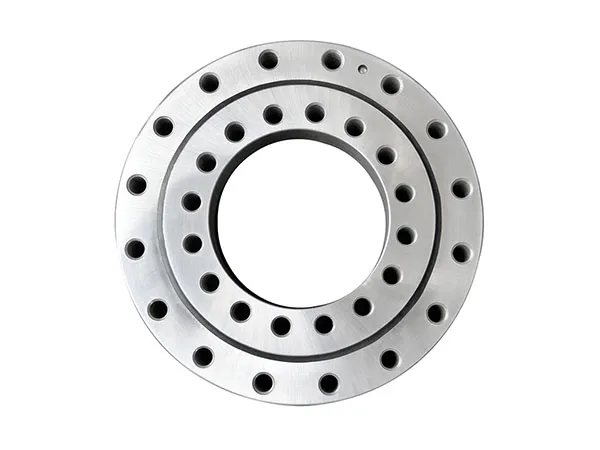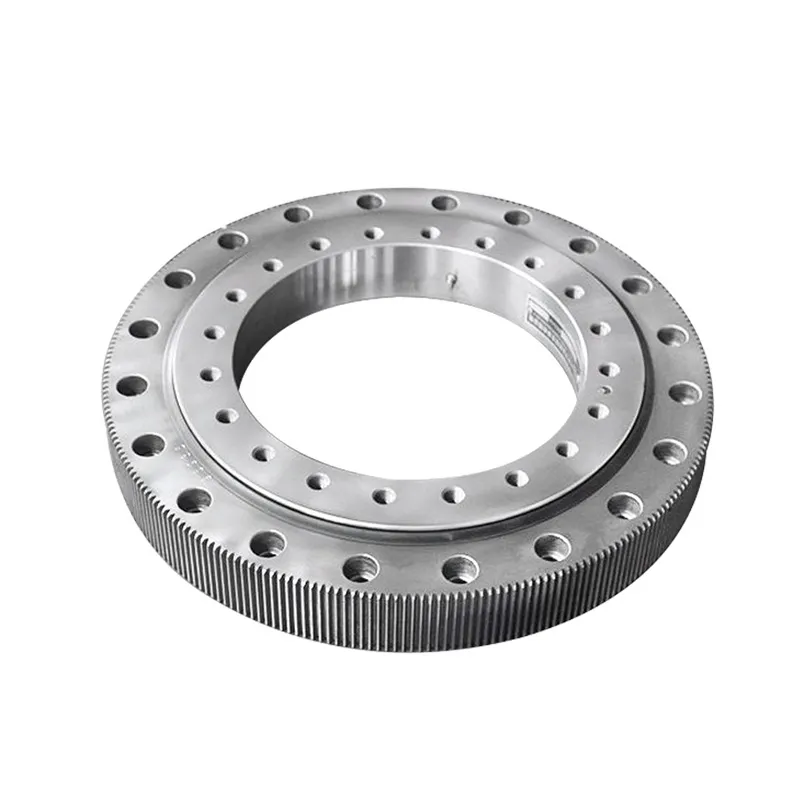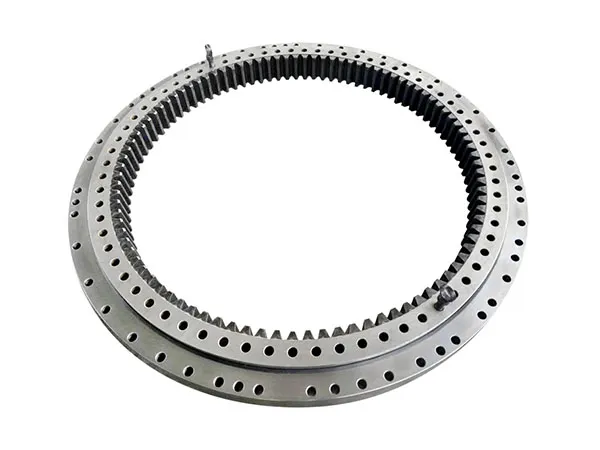- +86 13837949030 +86 15890619536
- info@lymcbearings.com export@lymcbearings.com
- Luoxin Industrial Cluster, Luoyang City,Henan Province,China
Time:2025-10-20 03:19:00 Source:LYMC Slewing Bearing
Bearings are the backbone of industrial machinery, acting as the “joints” that ensure smooth and efficient motion. With numerous bearing types available, distinguishing between slewing bearings and standard bearings can be challenging for engineers, maintenance teams, and procurement specialists. While both reduce friction and support loads, their design, functionality, and industrial applications differ significantly.
This guide provides an in-depth comparison, helping you choose the right bearing to maximize equipment performance, reduce downtime, and extend service life.

This article will demystify these two critical industrial components, delving into their core differences to empower you to make informed bearing selection decisions in complex industrial scenarios. This will optimize equipment performance and extend service life.
When we refer to “standard bearings,” we are actually addressing a vast category encompassing nearly all standardized components used to support rotating or linear motion parts. Their design purpose is to efficiently bear radial, axial, or combined loads. Below are common types of general-purpose bearings and their characteristics:
The Ingenuity of Rolling Bearings: These bearings convert sliding friction into rolling friction through precision rolling elements (e.g., balls, rollers) arranged between inner and outer rings. Common subtypes include:
Ball Bearings: Suitable for high speeds and light to medium loads, offering low friction performance.
Roller Bearings: Engineered for heavy-duty applications, including:
Cylindrical Roller Bearings (high radial load capacity)
Tapered Roller Bearings (combined high radial and axial load capacity)
Spherical Roller Bearings (self-aligning capability to accommodate shaft misalignment)
The Art of Standard Bearings:
These rely on lubricants forming an oil film between two moving surfaces to enable smooth sliding motion. Often manufactured from Babbitt alloy, bronze, or advanced composites, they are suitable for low-speed heavy loads or impact load environments.
Core Advantages of Standard Bearings:
Compact Design and High Standardization: Typically compact in size with extensive series availability, facilitating easy selection, procurement, and maintenance.
Exceptional High-Speed Adaptability: Many standard bearings, particularly high-precision rolling bearings, effortlessly handle high-speed applications, ensuring smooth power transmission.
Specialization in Specific Loads: They excel in handling radial or axial loads unidirectionally, or specific proportions of combined loads, enabling optimized design.
Universal Industrial Foundation: From miniature motors in household appliances to automotive engine drivetrains and precision machine tools, standard bearings are ubiquitous across industries.
Slewing bearings, also known as turntable bearings or large-diameter bearings, are specialized bearings tailored for large, heavy-duty equipment. Their unique capability lies in simultaneously withstanding massive axial loads, radial loads, and overturning moments. They typically serve as the core connecting component enabling slow yet powerful rotation between two large mechanical structures.
Imagine the “waist” of a giant excavator or the “neck” connecting a wind turbine tower to its nacelle—these are the domains where slewing bearings excel. They typically consist of inner and outer rings, rolling elements (balls or rollers) between them, and spacers.
The Unique Appeal of Slewing Bearings:
Master of Three-Dimensional Loads: This defines its core capability. It effectively handles immense downward pressure (axial force), lateral thrust (radial force), and complex twisting forces (overturning moments) that threaten to flip or tilt structures.
Massive Scale with High Integration: Slewing rings span diameters from hundreds of millimeters to several meters, or even larger. They often integrate gears, lubrication circuits, and sealing structures into a single, fully functional rotating connection module, simplifying the host machine's design.
Exceptional Low-Speed, High-Torque Performance: While not suited for high-speed operation, slewing bearings demonstrate unparalleled load-bearing capacity during low-speed, intermittent, or oscillating movements. They reliably transmit massive torque while withstanding static or dynamic heavy-load impacts.
Simplified Installation: Most slewing bearings feature pre-drilled mounting holes, allowing direct bolted connection to the upper and lower structures of equipment.
This significantly streamlines overall mechanical design and assembly processes.
The “Anchor of Stability” for Heavy Industry: Widely deployed in critical sectors including construction machinery (e.g., excavators, cranes, tunnel boring machines), offshore platforms, wind turbines, port handling equipment, large medical imaging systems (CT/MRI), solar tracking systems, and military radar antennas.

|
Feature Dimension |
Standard Bearing |
Slewing Bearing |
|
Key Features |
Reduce friction, support rotational or linear motion, and withstand single or combined loads. |
Simultaneously withstanding substantial axial and radial loads as well as overturning moments, enabling structural rotational connections. |
|
Size Range |
Typically small, ranging from a few millimeters to several hundred millimeters, and highly standardized. |
Large-scale, with diameters ranging from several hundred millimeters to several meters or even larger, often customized or specialized. |
|
Load Type |
Primarily designed to withstand radial or axial loads, or a proportional combination of both. |
Simultaneously withstand significant axial forces, radial forces, and overturning moments. |
|
Rotational Speed Capacity |
Suitable for high-speed or medium-to-high-speed rotation. |
Primarily used for low-speed, intermittent rotational or oscillating motion. |
|
Structural characteristics |
Typically, these are standalone standard components that do not incorporate integrated transmission or sealing systems. |
Highly integrated, often incorporating gears, lubrication ports, seals, and other components to simplify the host machine structure. |
|
Installation |
Various types, such as press-fit or bolted connections, typically require a bearing housing or casing. |
Directly bolted between the upper and lower structures to serve as the connection for the main body of the equipment. |
|
Application Scenario |
Automobiles, electric motors, home appliances, small machinery, industrial pumps, conveyor belts, etc. |
Excavators, cranes, wind turbines, port machinery, radar systems, medical CT scanners, solar trackers, and other large-scale equipment. |
|
Manufacturing costs |
Mass production results in relatively low unit costs. |
Complex design, high material consumption, predominantly custom-made, resulting in relatively high unit costs. |
|
Maintenance Features |
Easy to replace, highly standardized. |
Maintenance may involve extensive disassembly, but the design features a long service life and high reliability. |
Choosing between slewing bearings and standard bearings isn't simply a matter of superiority or inferiority, but rather a strict match based on your specific application scenario.
Scenarios for Standard Bearings:
If your equipment requires high-speed, smooth rotation and primarily handles unidirectional loads (e.g., motor rotors, vehicle hubs), while prioritizing space efficiency and cost-effectiveness, standardized, compact standard bearings offer a more economical and efficient solution.
Scenarios for Selecting Slewing Bearings:
When your machinery faces substantial self-weight, external impact loads, and must simultaneously resist massive axial and radial forces along with complex overturning moments at a single pivot point—while operating at relatively low rotational speeds (e.g., rotating platforms for large cranes, connections between wind turbine towers and nacelles)—slewing bearings become indispensable core components due to their multifunctional integration and exceptional load-bearing capacity.

Understanding the differences between slewing and standard bearings is essential for engineers, maintenance teams, and industrial procurement specialists. Choosing the right bearing ensures equipment reliability, optimal performance, and long service life.
Need Expert Guidance?
Our company offers professional consultation and premium bearing solutions. Whether you need high-speed standard bearings or robust slewing bearings for heavy machinery, our experts provide tailored recommendations and technical support to enhance your equipment’s performance.
Contact us today for a free bearing assessment!